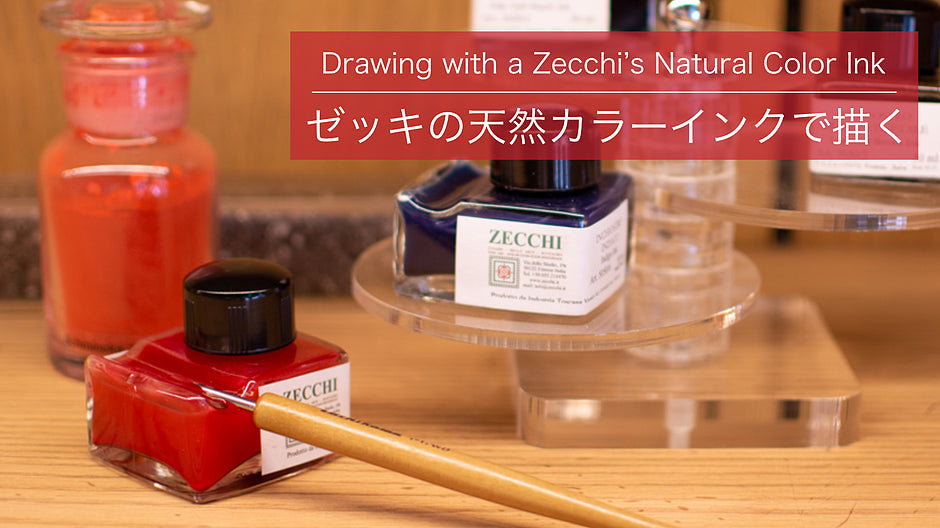PIGMENT TOKYO carries ZECCHI's natural color ink.
*The following items are no longer available at our store.
ZECCHI's color inks are all natural products. For example, Cochineal Carmine Red Ink is made from scale insects, Indigo Blue is made from the indigo plant, Logwood Brown is made from logwood and Oak Black is made from oak.
Moreover, gum arabic, honey and vinegar are added as mediums and additives, resulting in the gentle colors of natural materials.
Unlike the wall of pigments from our store, natural dyes are mainly produced from plants and animals.
The biggest difference between the dyes and the pigments is whether or not they are soluble in water. For example, if you drop a pigment onto a painting plate filled with water, it will not dissolve.
Pigments are like colored sand and need to be mixed with mediums like gum arabic, acrylic emulsions etc., to create the paint we use.
The following picture shows when Cadmium Red pigment mixed with a small amount of water. Since the pigments do not have the property of dissolving in water, they will not turn into colored water even if I left them like this for a while.

Therefore, what happens if it was cochineal? I place the cochineal insects which are the source of the dye on a plate and put a few drops of water on it.

As you can see, the familiar red color gradually seeped out. It provides a transparent red color that pigments don’t.

This is what it looks like when the whole thing is immersed in water and left for about 30 minutes. I know it might be a little strange to see such vivid colors coming out from what looks like a bunch of tiny black grains.
As you can see, natural dyes create water-soluble transparent colors, however, they have a weak lightfastness, so it is best to apply varnish after painting to prevent UV damage.

These natural raw materials are used to produce this ZECCHI's Cochineal Carmine Red Ink.
So how does the color appear when it is drawn on paper?
Let's try a simple test painting with this ink.
The first thing I did was to use an eyedropper to randomly drop some ink from the top and then spread it out with a wet brush. Even the darkest part which seems to be almost undiluted ink has a gentle tone that reminds me of natural materials.
The viscosity of this ink is low, so it is very suitable for creating smooth gradations like the picture shown.
Note: It is important to shake the ink bottle well before use.

【Art Materials Used】
Coloring: Cochineal Carmine Red Ink
Substrate :Bamboo Washi for Watercolor Art Pad
Next, I used Namura Taiseido's SK STARS No. 6 brush to draw straight lines with a groove ruler.
The concentration of the ink is very low, even when I dipped my brush directly from the ink bottle, therefore, it is probably more suitable for light coloring on watercolor paper than creating a hard-edged painting.
The fact that the ink maintains a constant density even after drawing a long line is because of its low viscosity and smooth drawing ability.

【Art Materials Used】
Coloring: Cochineal Carmine Red Ink
Substrate :Bamboo Washi for Watercolor Art Pad
At last, I used a round pen to draw a couple of thin straight lines in a row.
As you can see, you can draw darker lines by putting a little force on them.
This time, I drew on bamboo washi paper (for watercolors), which absorbs water a little, but I am sure the edge of the lines may bleed or change if you try it on a different paper.

【Art Materials Used】
Coloring: Cochineal Carmine Red Ink
Substrate :Bamboo Washi for Watercolor Art Pad
Nowadays, color inks have evolved in a variety of ways and various types of products are available from many manufacturers, including water-resistant pigment inks and scientifically produced artificial dye inks.
However, the use of natural inks, which have been used since ancient times, can provide an unexpected and unique color to your work.
Therefore, it is a great way to enjoy the subtle red tone that cannot be achieved with artificial products.
Translated by Atsumi Okano
PIGMENT TOKYO Art Materials Expert






